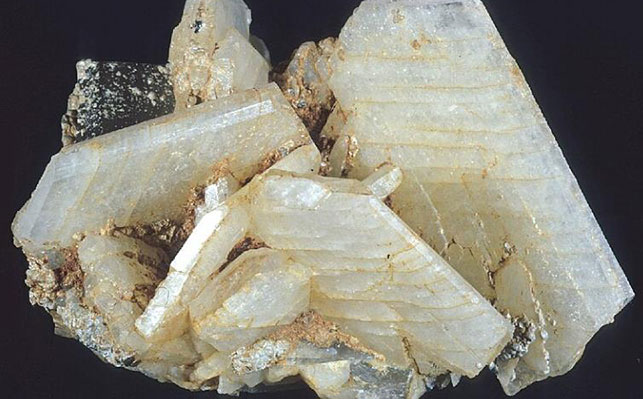High-purity feldspar can be used in the glass industry and the ceramic industry. In the glass industry, feldspar can reduce the melting temperature in glass production, reduce the amount of soda ash, and adjust the viscosity of the glass liquid. In the ceramic industry, feldspar in the ceramic blank can speed up the drying of the blank, reduce drying shrinkage and deformation; it can also reduce the expansion coefficient and high-temperature fluidity of the glaze, and improve the corrosion resistance. So, how to purify feldspar from feldspar ore? There are mainly the following methods.

Feldspar ore is usually doped with harmful impurities such as mica, iron oxides, rutile and amphibole, which will affect the quality of feldspar. Therefore, feldspar purification is essentially to remove these impurities and improve the purity and whiteness of feldspar. For different impurities, the following methods can be used to remove them:
The principle of color sorting and purification of feldspar is to complete the purification based on the color difference between feldspar and gangue minerals such as muscovite and quartz. Its purpose is to remove blocky impurities such as muscovite and quartz in advance to prepare for subsequent purification, or to separate low-grade from high-grade feldspar.
Commonly used equipment is color sorter. In foreign countries, the application of ore color sorter is relatively mature. In the future, the development direction of my country's mineral processing industry will be green, intelligent and environmentally friendly. Therefore, color sorter is expected to be rapidly promoted and applied in my country's mineral processing and purification industry.
Water washing and purification uses the difference in particle size and density between feldspar and fine impurities such as clay to achieve separation. Its purpose is to remove impurities such as clay, mica, and fine mud. Commonly used equipment includes centrifuges, desludging buckets, hydrocyclones, ore washing troughs, vibrating screens, etc., and commonly used agents are dispersants. For feldspar ores produced from feldspar sand or weathered granite, primary and secondary ore muds can be removed in advance to prepare for subsequent mineral processing.
Magnetic separation and purification uses the magnetic difference between feldspar and impurities such as iron oxides, mica and garnet to achieve separation. Its purpose is to remove weakly magnetic minerals such as iron oxides, mica and garnet from feldspar ores. The effect of magnetic separation and iron removal of feldspar is mainly affected by the magnetic field intensity and the number of magnetic separations. The higher the magnetic field intensity and the more magnetic separations, the less iron content in the ore. Pulsating current can also improve the iron removal effect. In actual production, reasonable magnetic separation equipment, processes and parameters should be selected in combination with ore characteristics and product quality requirements. All types of magnetic separation equipment can be used for magnetic separation and purification of feldspar.
Flotation purification uses the difference in surface properties between feldspar and gangue minerals such as mica and quartz to achieve separation. Its purpose is to remove impurity minerals such as mica, quartz, pyrite, mica, garnet, tourmaline, amphibole, ilmenite, rutile and titanite. Common equipment includes flotation machines and flotation columns, and common reagents include collectors, frothers and inhibitors. Flotation is a widely used method for impurity removal and purification of feldspar, and it is also an important means of separating feldspar and quartz.
Acid leaching purification uses acids to selectively dissolve iron-containing minerals in feldspar. Its purpose is to remove impurities with extremely fine crystalline structures in feldspar. Commonly used acids include hydrofluoric acid, hydrochloric acid, sulfuric acid, nitric acid, oxalic acid, etc. Oxalic acid has strong acidity, stronger reducing power than other inorganic acids, and good complexing ability. It is currently the most effective organic acid for dissolving iron oxides and is widely used in feldspar iron removal. Generally, the greater the acid volume fraction, the higher the temperature, and the longer the acid leaching time, the better the iron removal effect.
The reduction method is to make the reducing agent react with the iron oxide in the feldspar under acidic conditions, and the trivalent iron is reduced to divalent iron, which is removed after filtering and washing. Its purpose is to remove iron and whiten. Commonly used reducing agents are sodium dithionite, etc. The reduction method removes iron, the product whiteness is stable, and the environmental pollution is small, but the price of solid sodium dithionite is relatively expensive at present, and it is necessary to pay attention to its easy decomposition and oxidation.
High-temperature chlorination method uses chlorine gas at 700-950℃ to react with the impurity iron in the feldspar to generate ferric chloride salt with a lower boiling point, and separate iron in a volatilized form. Its purpose is to remove iron and whiten. Commonly used equipment is chlorine gas. High-temperature chlorination method has high efficiency and good effect in iron removal, no new impurities are introduced, and the properties of the raw materials themselves are almost unchanged, but the cost is higher than other methods, and chlorine is toxic, so environmental pollution should be avoided when using it.
The microbial leaching method uses the metabolites of microorganisms to react with iron impurities, and then uses other methods to remove impurities. Its purpose is to remove iron and whiten. Commonly used equipment is strains, etc. The microbial method has low operating costs and low energy intensity. The reaction does not need to be carried out under high temperature conditions, and it will not cause environmental pollution. It is in line with the theme of environmental protection, energy saving, and consumption reduction advocated by today's society. Due to the different culture cycles of microorganisms, different strains have different iron removal efficiencies for different types of minerals, and microbial impurity removal needs to be further optimized and promoted.